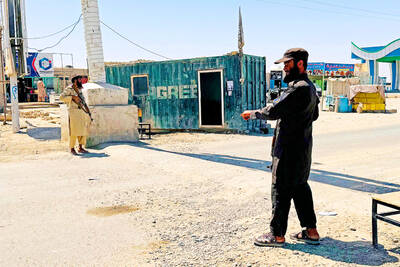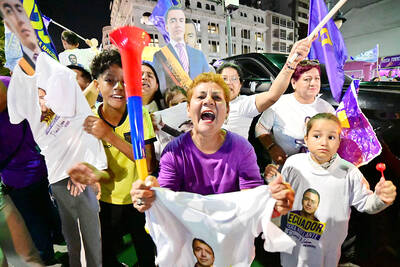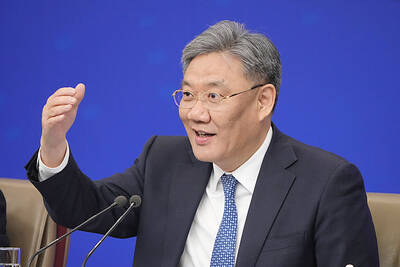Tajikistan’s mountainous Gorno-Badakhshan Autonomous Oblast (GBAO) is home to a rickety highway that is among the world’s great road adventures.
However, the region famed for its lunar landscapes and verdant valleys has a darker side. In the past few weeks, Tajikistan’s authoritarian government has cracked down hard on the restive region, which borders China and Afghanistan, and which tried to break away from Dushanbe in 1992.
At least 17 people were killed and more than 200 arrested during what the authorities call “an anti-terror operation,” with a communications blackout limiting information coming out of the region.
However, critics say that the real aim of the crackdown is to crush local leaders, who in the past have resisted Tajik President Emomali Rakhmon’s rule.
State information bulletins have trumpeted the operation as a success.
The state information service Khovar on Friday said that “12 leaders of organized criminal groups” had been detained during the operation and 16 people “neutralized” after resisting arrest.
“The activities of organized terrorist groups on the territory of Badakhshan have been completely stopped,” the service reported.
Authorities last month said that one member of the security services was killed during fighting.
Raids in the region followed anti-government protests last month and triggered a joint statement of “deep concern” from France, Germany, the UK and the US.
The Internet blackout has been criticized by rights groups, while private media outlet Asia-Plus said it ceased reporting on the situation “under threat of closure” by authorities.
Hemmed in by the towering Pamir Mountains and further isolated by poor transport infrastructure, Gorno-Badakhshan accounts for about half of Tajikistan’s territory, but only 2 percent of the nation’s 9.5 million population. Its peoples mostly speak languages distinct from the official Tajik spoken elsewhere in the former Soviet republic and follow Ismaili Shia Islam, rather than the nationally prevalent Sunni Islam.
Yet it is the isolated region’s penchant for political opposition, stretching back to a civil war in the 1990s, that rankles with the regime in the capital, activists say.
“They want to impose the same order on us that they have imposed elsewhere in Tajikistan. The order of one corrupt family,” said Alim Sherzamonov, an opposition leader who fled to Europe, referring to Rakhmon and his powerful family members.
Sherzamonov, deputy chairman of the diaspora-led National Alliance of Tajikistan, is one of several activists the government has accused of fomenting protests that set the stage for the operation.
The pro-autonomy demonstrations followed tensions between locals and centrally appointed officials, accused of carrying out campaigns of persecution.
Dozens of citizens of Pamiri descent living in Tajikistan have since been arrested “on ethnic grounds,” Sherzamonov said.
He denied having any role in the protests and said that his brother, who is not politically active, had been detained in the sweeps.
“This operation really started over a decade ago. They have reached their aim,” Sherzamonov said. “Many people are losing the will to keep fighting for their freedom.”
The violence is the worst in the region since 2012, when dozens died during clashes between government forces and fighters loyal to local informal leaders.
China — Tajikistan’s top foreign investor and largest creditor — has reportedly set up a base in the strategic region.
Beijing has not officially acknowledged the facility’s existence, but Tajikistan last year said that China was helping it build a separate base where Tajik special forces would be stationed.
The men named in Tajik state media reports of the latest deaths and arrests are recognized as informal leaders in Gorno-Badakhshan, which sits along the heroin trail that heads north from Afghanistan across the Panj River.
Some of them fought against troops loyal to Rakhmon during the civil war and were later handed government security posts as part of a peace deal that Tajikistan’s ally Russia helped broker.
However, none of the men held state positions at the time the new operation began, an indication that the government grew tired of power-sharing, observers say.
One particularly popular local leader, Mamadbokir Mamadbokirov, was killed “as a result of internal clashes of criminal groups,” police said last month, contradicting opposition reports that said Mamadbokirov was slain by government forces.
Zafar Abdullayev, a Tajik journalist who lives in the US, last month said in a YouTube broadcast that authorities’ simultaneous descriptions of the men as gangsters, terrorists and narcotics kingpins “do not withstand scrutiny.”
“They throw in all these different terms to say: They are bad guys,” Abdullayev said.
John Heathershaw, a professor of international relations at the University of Exeter said Tajikistan’s “authoritarian approach to conflict management” has done little to solve tensions in the troubled region.
“[The regime] systematically takes out rivals that challenge its domination over the economy, political space and public discourse,” Heathershaw said.

‘EYE FOR AN EYE’: Two of the men were shot by a male relative of the victims, whose families turned down the opportunity to offer them amnesty, the Supreme Court said Four men were yesterday publicly executed in Afghanistan, the Supreme Court said, the highest number of executions to be carried out in one day since the Taliban’s return to power. The executions in three separate provinces brought to 10 the number of men publicly put to death since 2021, according to an Agence France-Presse tally. Public executions were common during the Taliban’s first rule from 1996 to 2001, with most of them carried out publicly in sports stadiums. Two men were shot around six or seven times by a male relative of the victims in front of spectators in Qala-i-Naw, the center

Incumbent Ecuadoran President Daniel Noboa on Sunday claimed a runaway victory in the nation’s presidential election, after voters endorsed the young leader’s “iron fist” approach to rampant cartel violence. With more than 90 percent of the votes counted, the National Election Council said Noboa had an unassailable 12-point lead over his leftist rival Luisa Gonzalez. Official results showed Noboa with 56 percent of the vote, against Gonzalez’s 44 percent — a far bigger winning margin than expected after a virtual tie in the first round. Speaking to jubilant supporters in his hometown of Olon, the 37-year-old president claimed a “historic victory.” “A huge hug

Canadian Prime Minister Mark Carney is leaning into his banking background as his country fights a trade war with the US, but his financial ties have also made him a target for conspiracy theories. Incorporating tropes familiar to followers of the far-right QAnon movement, conspiratorial social media posts about the Liberal leader have surged ahead of the country’s April 28 election. Posts range from false claims he recited a “satanic chant” at a campaign event to artificial intelligence (AI)-generated images of him in a pool with convicted sex offender Jeffrey Epstein. “He’s the ideal person to be targeted here, for sure, due to

DISPUTE: Beijing seeks global support against Trump’s tariffs, but many governments remain hesitant to align, including India, ASEAN countries and Australia China is reaching out to other nations as the US layers on more tariffs, in what appears to be an attempt by Beijing to form a united front to compel Washington to retreat. Days into the effort, it is meeting only partial success from countries unwilling to ally with the main target of US President Donald Trump’s trade war. Facing the cratering of global markets, Trump on Wednesday backed off his tariffs on most nations for 90 days, saying countries were lining up to negotiate more favorable conditions. China has refused to seek talks, saying the US was insincere and that it